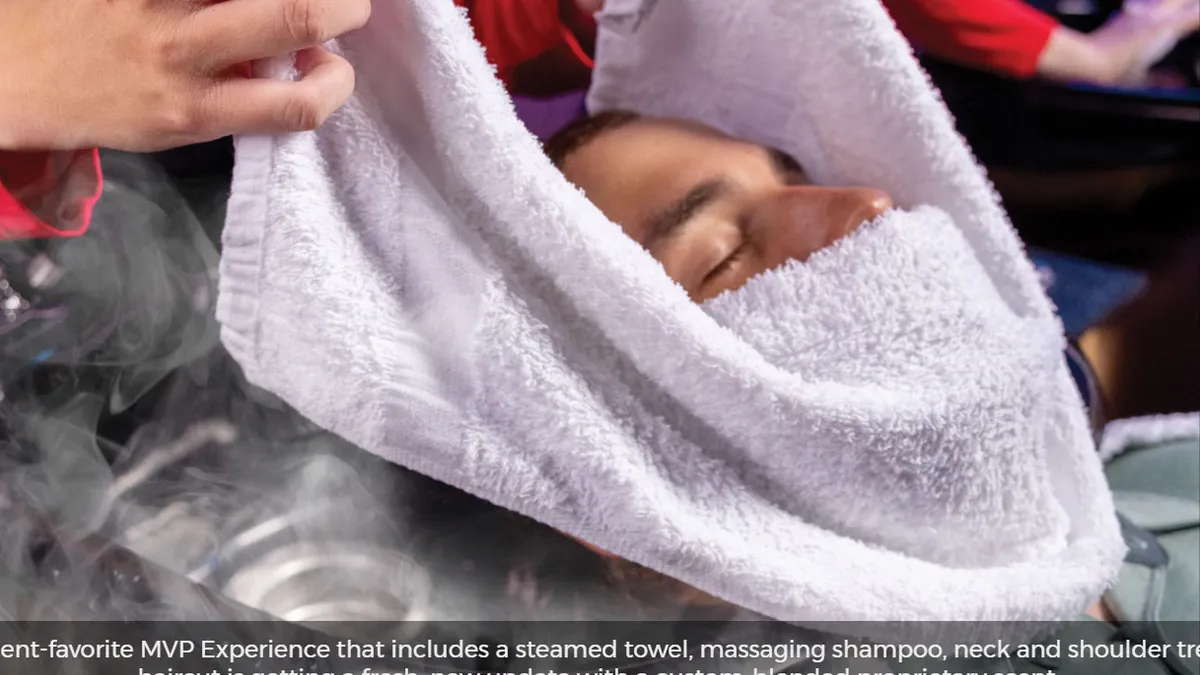Campaign Trail is our analysis of some of the best new creative efforts from the marketing world. View past columns in the archives here.
When hair salon franchise Sport Clips wanted to promote its newly revamped MVP Haircut Experience, it settled on autonomous sensory meridian response (ASMR) as a way to immerse streaming listeners in the multi-sensory service. The results — including a 15% jump in brand awareness — point to the potential of audio beyond sonic branding.
Though brands such as Anji, Michelob Ultra, Zippo, and Toyota have experimented with ASMR — which refers to the pleasant sensation some sounds produce — its use hasn’t become widespread in advertising. For Sport Clips, which has close to 1,900 locations, taking its target audience of men on an audio trip through a signature service that includes a shampoo, haircut and a hot towel treatment made sense because of how ASMR encourages listeners to use their imaginations to fill in the gaps between what they’re hearing and the in-person experience.
“We wanted to go deep into the experience and bring it to life in a 30-second script,” said Danielle Linden, Sport Clips’ senior director of marketing. “We promote the MVP service as a relaxing experience. That’s how many people experience ASMR, and we knew the MVP did that too.”
The right balance
Visiting a barbershop or salon is a unique sensory experience, what with the sound of scissors snipping, electric clippers humming, the smell of disinfectant and the feel of having one’s hair shampooed. For a marketer, appealing to these senses can be a bounty of opportunity. The challenge, on the auditory front, is finding the right balance of sounds.
Aural accuracy is extremely important because wrong sounds could result in the sense of “nails on a chalkboard [rather] than something soothing,” per Scott Simonelli, CEO of Veritonic, which worked on the campaign. That’s why creatives at audio agency Gwynne Sound, another campaign partner, spent days going through Sport Clips’ MVP experience to ensure precise sounds were used in a campaign that launched in April, primarily across Pandora, Spotify and Soundcloud.
“Let’s play a game,” whispers a woman’s voice in one ad. The sound of her voice alternates through headphones as she says: “I’m going to play a series of sounds from Sport Clips, and I want you to guess what they are.” This is followed by sounds of scissors and water. After a whooshing sound of the wind, the woman’s voice concludes: “It’s the MVP Experience only at Sport Clips.”
A second version is more direct, declaring, “This is your mind of a busy old workday,” as traffic noises and computer alerts and other sounds play. The voice drops to a whisper to say, “And this is your mind during the MVP Haircut Experience,” as soothing noises, including of water and wind, play. The whisper declares it “the most relaxing haircut ever.”
“[ASMR is] somewhat disruptive,” Linden said. “There’s not a lot of brands that have done it, and we wanted to bring it to life in a new way. This has been a very eye-opening experience for me.”
Machine listening
The audio experience went through pre-market testing by Veritonic, which used its audio creative testing technology to help pinpoint the best voice over and script for representing the MVP experience. The testing included quantifiable intelligence (based on other campaigns and data) to assess key metrics, including brand lift, intent, recall and engagement.
“We train our system to listen like a person,” said Simonelli. “We call it machine listening. It's taking the same concepts and applying them to audio.”
The ASMR spots proved to be successful, beating Veritronic’s retail benchmarks. Among key indicators, brand awareness increased 15% (48 hours after exposure to the ads) and brand favorability rose 2%. Additionally, 50% of the target audience reported feeling soothed by the advertising while 43% felt the ads kept their attention.
“Audio is a rich piece of content. It’s not static and it gives people goosebumps,” said Simonelli.












